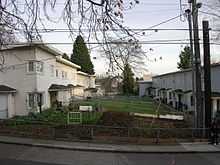Yesler Terrace, Seattle



Yesler Terrace, a 22 acre (89,000 m²) public housing development in Seattle, Washington was, at the time of its completion in 1941, Washington State's first public housing development and the first racially integrated public housing development in the United States. It occupies much of the area formerly known as Yesler Hill, Yesler's Hill, or Profanity Hill. As of 2005, it is administered by the Seattle Housing Authority, and is Seattle's only remaining large public housing development that has not been converted into a mixed-income neighborhood.
Yesler Terrace is located on the southernmost part of First Hill, along Yesler Way immediately east of downtown Seattle. Uphill across Interstate 5 from Pioneer Square and the International District. Much of the site included Nihonmachi or Japantown until Executive Order 9066 ordered residents to be interned. Yesler Terrace consists of several hundred two-story rowhouses and a small number of community buildings. Unlike most public housing developments, residents have their own private yards.
The name derives ultimately from Henry Yesler, pioneer mill owner. Yesler Way was originally the skid road on which logs were skidded down to the mill. The southern part of the hill came to be known as Yesler's Hill, Yesler Hill, or Profanity Hill. These names referred roughly to the part of First Hill south of the old King County Courthouse at 8th Avenue and Terrace Street. Razed in 1931, the courthouse site was roughly the western portion of the present-day Harborview Medical Center. The name "Profanity Hill" could have its origins from the cursing of the attorneys and litigants at having to climb so steep a grade, or because of the slum neighborhood known for its uncouth inhabitants to the south where Yesler Terrace is now situated.
As of 2005, there are 1,167 residents. An estimated 40% of households are Asian or Asian American, 38% are African or African American, 11% are White, and 3% Native American.[1]
Plans are currently afoot to convert Yesler Terrace, like other Seattle public housing developments, to mixed-income use. Residents have been organizing to demand that any plan for redevelopment include the opportunity for all residents who wish to remain to do so. They have also circulated a petition opposing any plan that would reduce the number of units available to the poorest residents.[1]
Notes and references
- ↑ 1.0 1.1 Hyla, Adam, "Yesler Terrace: future in question", Real Change (Seattle), March 23–29, 2005, p.4.
External links
| Wikimedia Commons has media related to Yesler Terrace, Seattle. |
- Yesler Terrace, Seattle Housing Authority. Includes links to pages relevant to the current planning process.
- Seattle City Clerk's Neighborhood Map Atlas — Yesler Terrace
Coordinates: 47°36′08″N 122°19′12″W / 47.60222°N 122.32000°W